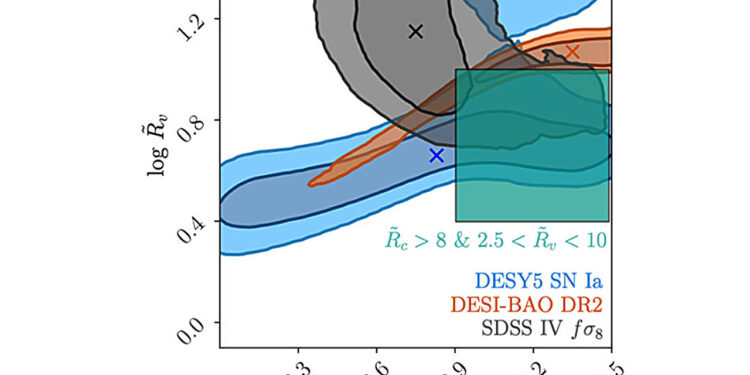The layout represents the new model with the X axis and the axis showing the minimum sizes of collapse and expansion regions which can have an impact on cosmological measurements. Contours are independent data sets. Credit: Dr Leonardo Giani
A researcher from the University of Queensland has developed a new mathematical model to explain the evolution of the universe which, for the first time, includes the collapse of the regions of material and expanding gaps.
Dr. Leonardo Giani and a team from the UQ mathematics and physics school used data from the black energy spectroscopic instrument (DESI), which has measures from the universe at 11 billion light years. Research was published in Physical examination letters.
“This new model can change the way physicists and cosmologists look at the universe,” said Dr. Giani.
“The standard model mapping the universe of Big Bang until today has particles of material of the same size which do not interact with each other.
“But in reality, we can see that there are stars, black holes, clusters of galaxies and empty regions in interaction constantly via forces such as gravity which is not taken into account by the standard model.
“For 30 years, scientists have tried to explain what is happening as this complex universe is developing and there have been many exotic attempts at solutions.
“We know that the voids and the collapsing regions exist, but we did not really know how to calculate their impact on the measurements.
“My model gives a recipe to calculate it, without the need for new physics.
“This framework uses simple mathematical terms to describe how the emergence of complex structures in the universe affects our cosmological measures.”
Dr. Giani’s team has decided to identify the minimum size that a vacuum must have an impact on measurements (called R_V) as well as the minimum size that a cluster must have (called R_C).
Independent data sets, including desi data, have been drawn on an X axis and an axis showing the minimum sizes of the collapse and expansion regions which can have an impact on cosmological measurements.
“The standard model of the universe should see all these contours of the data set overlapping in the upper right corner, where the sizes of the expansion and contracting regions would be too important for them to exist,” said Dr. Giani.
“They overlap rather in a different region, which indicates that large space empty could be responsible for the abnormal behavior observed in the data.”
Dr. Giani said the new model also addresses the two biggest problems in modern cosmology: reduction tension and proof of dynamic dark energy.
Hubble tension is a difference between two methods of calculating the universe expansion rate, while dynamic dark energy is a theory that says that energy is not constant but changes or weakens in time.
“Our model has the richness to resolve these two,” said Dr. Giani.
“If you assume that the dark energy is weakening and then try to deduce how fast the universe extends from this data, you even get a lower measure of the universe expansion rate – the solutions to a problem create another.
“In our model, any weakening of energy is only a detailed accounting of what the universe looks like today, it behaves as if it were weakening but may not weaken.
“In our plot, the green box is a region where hubble tension is resolved.
“Essentially, when we asked if the complexity of the universe appeared in the desi data, the result was that it was, and our framework can explain all observations.”
More information:
Leonardo Giani et al, new approach to cosmological non-linearities as an effective fluid, Physical examination letters (2025). DOI: 10.1103 / ZR92-M7PY. On arxiv: DOI: 10.48550 / Arxiv.2410.15295
Provided by the University of Queensland
Quote: The mathematical model reveals how the collapse of matter and the expansion of voids shape the evolution of the universe (2025, August 19) recovered on August 20, 2025 from
This document is subject to copyright. In addition to any fair program for private or research purposes, no part can be reproduced without written authorization. The content is provided only for information purposes.



